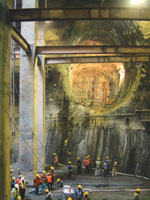 |  |
| Breakthrough. Delhi Metro had first machine-driven subway tunnel in India. (Photo left courtesy of Dywidag International, right by AP/Wideworld) | |
Contractors and design firms are now preparing to bid for the next phase of the rapidly expanding metro system in Indias capital. The first underground section, completed this summer, is impressing locals and visitors with its spacious, air-conditioned calm, contrasting with the frenetic atmosphere above in Old Delhis teeming streets.
Costing about $2.3 billion, the metros 66-kilometer first phase was completed in stages over some seven years, starting in October 1998. That included the underground north-south Line Two, with 6.6-km of Indias first machine-driven subway tunnels. The overall schedule was three years shorter than originally proposed by the government, says E. Sreedharan, managing director of Delhi Metro Rail Corp (DMRC).
 |
|
Almost There. Line Two debuted last summer (left) and other work is wrapping up. (Photo courtesy of DMRC) |
As a pioneering design-build project of such a scale, building the metro's tunnels and underground stations was arduous. "There were a lot of additional works," says K. Manivannan, of locally based Larsen & Toubro Ltd. The company worked on the bored tunnels with Germany's Dywidag International GmbH. and Japanese and Korean contractors. At $440 million, the contract ended 16% over the original estimate. Soil conditions varied, but included sand and clay and even building rubble from the Mogul period, says Manivannan.
Everyone went through a learning curve, says Chris Davis, a director of Mott MacDonald Group, London, which worked for the bored tunnel contractors. "DMRC found it very difficult....When you go for design-build, you have to make your decisions before you go to tender rather than after," he says. But the final outcome was a success, he adds. "Its a first-class metro."
Both inside and outside DMRC, Sreedharan is credited for driving the project successfully. He is variously described as a "tough cookie," uncompromising and adept at cutting through the bureaucracy that has plagued other Indian mega-projects. His management of the metros construction comes after long engineering service with Indian Railways, and recent leadership of one the worlds greatest railroad projects.
 Indian contractors "rose to the occasion." |
Born in 1932, Sreedharan has been a railway engineer for almost all his career. He was anticipating retirement as what he thought would be his last great project neared completion. But as chairman and managing director of the company building the 760-km Konkan railway, down the west of India, Sreedharan was invited onto a committee scouting for a leader of the metro program.
The committee failed to find suitably qualified candidates and the Japanese funders of roughly two-thirds of the project became impatient, says Sreedharan. Though he was three years beyond the normal public service retirement age of 62, he accepted the post in November 1997.
Sreedharan brought to Delhi first- hand memories of the notorious project to build Indias first metro in Kolkatta (formerly Calcutta). He had been deputy chief engineer in charge of planning and design on Indian Railways and had a hand in that project, which was completed in 1995.
Building Kolkattas 16.5-km-long line in mainly cut and cover took over 20 years and was many times over budget, says Sreedharan. And by disrupting normal life for years, "the experience of Calcutta was not good for the city or the country," he adds.
The project had sporadic, piecemeal funding and also suffered from the decision to develop the system without foreign technical support, Sreedharan says. In Delhi, "we admitted we didnt have the expertise," he says. So he recruited an international team led by Tokyo-based Pacific Consultants International as general consultant and which also included Parsons Brinkerhoff International Inc.
At the same time, the Japan Bank For International Cooperation required global bidding for the underground sections. Dywidag led the bored tunnel portion and Skanska A.B., Stockholm, had the same role on the 4.1-km cut-and-cover contiguous northern section.
DMRC secured robust funding through soft loans from Japan and Indian government commitments. The corporation appears also to have benefited from its unusual autonomy for an Indian public entity. Owned equally by the governments of India and Delhi, the 10-year-old corporation avoided political manipulation and had flexibility and freedom to make decisions, says Sreedharan.
The largely elevated 22-km east-west Line One was completed early last year, followed by the 11-km north-south underground section of Line Two. Work on Line Three and the underground station is due to end next March.
DMRC now is gearing up to start bidding construction contracts for the next tunnelled section, extending Line Two southward early next year. More cut-and-cover work will also be on the market, raising the value of underground construction to over $300 million, estimates Sreedharan.
With the generally successful work so far, "DMRC has changed the construction culture of India," says Sreedharan. "We follow all the international practices," he adds. Putting barriers around sites and diverting utilities in advance, for example, "were not common," he adds.
With over 180 km of lines planned for the system, Sreedharan believes Indian firms could handle future work alone. But he still welcomes foreign participation. At the projects inception, the Indian construction industry "did not have a very good image," says Sreedharan. But having completed phase one, he believes local firms "rose to the occasion."

Post a comment to this article
Report Abusive Comment